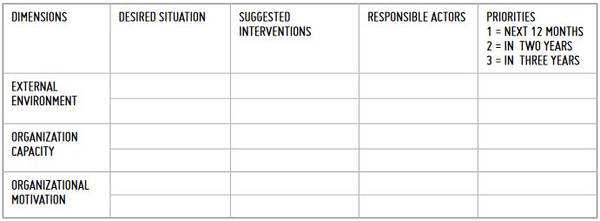Visioning exercise
When to use it
A visioning exercise is a powerful tool to use when engaging in strategic planning. It is very useful to design a new organization (formalization phase) or when the organization is driving a large-scale change (reinvention phase). Visioning is essential to any successful organizational change. It serves to motivate and energize people, gain commitment and provide direction. This tool can be applied during a strategic planning workshop or meeting to design a change strategy for a single organization or for an MSP, such as a value chain capacity-strengthening process.
What it is
Visioning is a process of creating a compelling statement about what an organization aspires to be or to accomplish in the mid-term (i.e. five years from now) or in the long-term future (10 or 20 years from now). A vision is a mental picture of the organization’s or MSP‘s ideal future which is shared by its leaders, staff and members. To develop a vision, all parties involved need to communicate their aims clearly and unambiguously. When people are involved in creating a vision, it becomes “our vision”. A vision generates a common goal, hope and encouragement. It offers a possibility for radical change, and also gives people motivation and goals to move towards, generating creative thinking and passion. The vision lays the foundation for strategic planning and for the development of action plans. It will determine decisions, choices and activities within the organization or MSP.
A great change vision is:
- both rational (intellectually solid) and inspirational (an emotional appeal);
- clear and succinct. It is a description that is easy for people to understand. “It can be written in a half page, communicated in 60 seconds” (Kotter, 2011); and
- shared by the broad range of staff and members of an organization, its clients and other stakeholders.
How to use it
The process of creating a common vision involves three main steps, and it is normally done in a workshop setting.
Step 1: Share the individual visions (10 minutes)
During this first step, the facilitator tells the participants: “Imagine that it is ten years from now and that your organization is the best, the most successful model of an organization at the local or national level. You are proud to be a staff member or leader of this organization which you helped to create. You have a very strong feeling of membership. Let’s dream! Let’s be a magician!”
First, every participant presents to the others in the group his/her vision of what he/she sees for the future for his/her organization. All the ideas are recorded on a flipchart. At this stage, there is no discussion among the participants, only questions of clarification if necessary. All ideas are welcomed, without value or judgment, as all ideas are good and potentially interesting for the future design of the organization. Second, the participants are invited to improve the ideas of others and to create a rich picture of the ideal future.
Outcome : Individual expression of what participants want to see in the future
Step 2: Develop a collective creative vision (30 minutes)
In this second step, invite participants to design an inspiring model that draws on the similarities of the participants’ ideas. This model can be taken from any sphere of the economic and social world, even an animal, a plant, a mineral or other concrete things.
Ask participants to list all the key characteristics which, in their opinions, have to distinguish their organization ten years from now. They should draw their vision clearly enough to allow others to see and understand it.
Outcome : Written group description of what participants want to see in the future for their organization
Step 3: Harmonize the individual visions within a common vision (20 minutes)
In this third step, construct a common vision among all the participants. Ask each group to report to plenary the contents of its group discussion and to present its drawing.
Afterwards, encourage the merging of the group visions into a common statement summarizing the vision for the organization. “In 10 years time, we shall have created... “.
Outcome : Agreed common vision for the organization
An external facilitator should conduct this session as it needs to be someone without a stake in the future organizational design. The facilitator can support the discussion and reflection process objectively and encourage the group to:
- be positive;
- be specific; and
- be open to dramatic changes to the current organizational structure.
Source: Guide du facilitateur. Rencontres nationales sur le Tournesol au Burkina Faso. (Facilitator Guide. National sunflower days in Burkina Faso) March 2013.
Exercise 6: Beginning to bridge the gaps
Purpose
Chapter 2 highlights the phases for planning and implementing an organizational change process. This exercise helps managers and staff in their discussions about desired changes for the future
Instructions : In plenary, take one hour to identify and discuss the following topics:
- the major gaps between the organization’s present situation and the vision created in the visioning exercise; and
- the priority areas that the organization has to address to bridge the gaps between the current state and the envisioned state.
CAM Summary Table

- Adapted: FAO Learning Module 2 ”Capacity development approaches in programming. Processes and tools”, 2012. Lusthaus et al. ,1999; http.kstoolkit.org.; « Rencontres Nationales du tournesol au Burkina Faso. Guide du facililtateur » (National Sunflower Days in Burkina Faso. Facilitator Guide), 2013.
